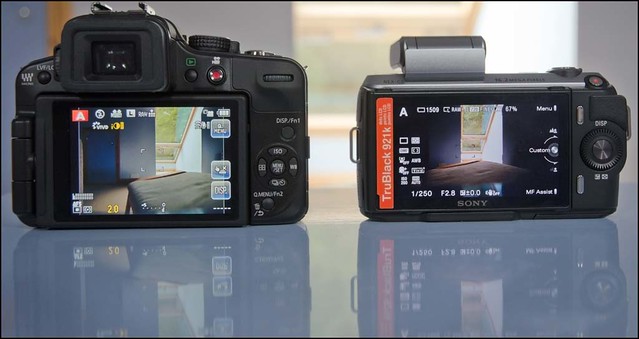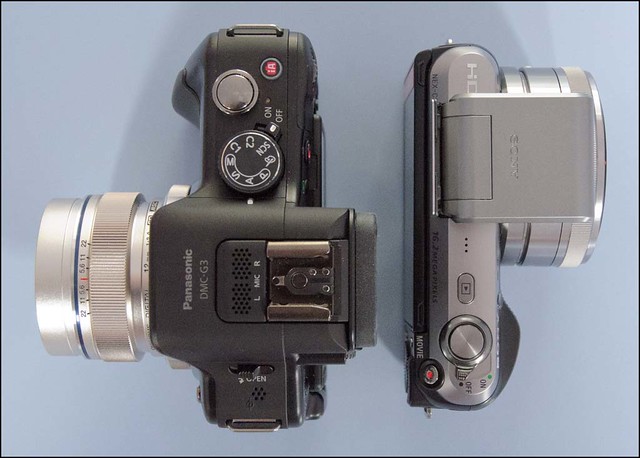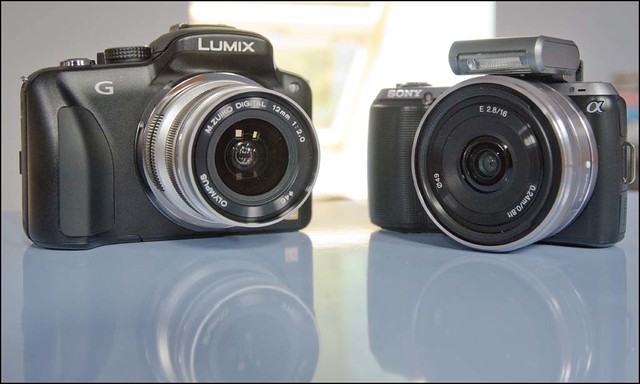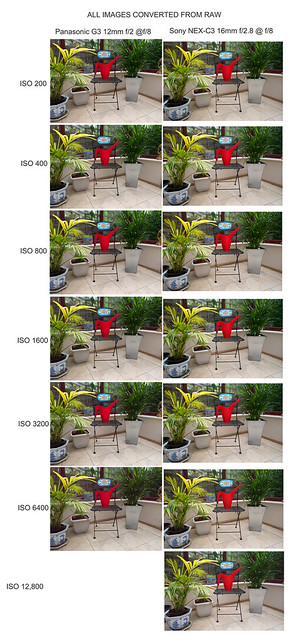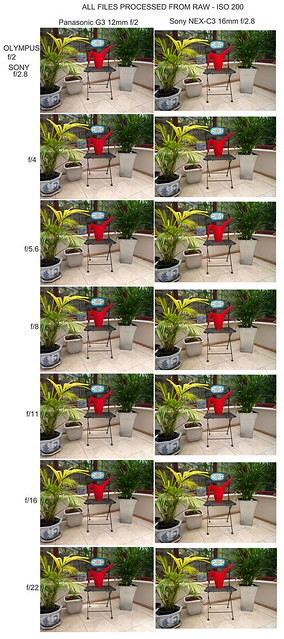In the first test I compared the two lens / camera combinations at ISO's from 200 to 6400, processed from raw. The Sony has an ISO 12,800 setting also.
Larger versions of all these tests are available by clicking on image to flickr, then Actions > View all sizes > Original
As is my usual practice, the cameras were tripod mounted and all images were processed identically using Photoshop and Adobe Camera Raw at the factory default settings.
This shows quite clearly that processing from raw the Sony produces a much cleaner result than the Panasonic.
I did the same thing using the out of camera jpgs.
This is much less clear cut. There is somewhat more noise reduction applied to the Panasonic files, resulting in a certain loss of detail, but the differences are less obvious. I was surprised at how much closer they were. I was expecting the G3 files to look much worse.
The following is a comparison of the various aperture settings of the two lenses. I used ISO 200 for both cameras.
The Sony 16mm f/2.8 gets a pretty bad press. But here under controlled conditions and on a tripod, it compares pretty well with the Olympus 12mm f/2. The edges on the e-mount lens are somewhat softer than the m4/3 lens, but again its a better performance than I was expecting. Overall the 12mm produces sharper results, but even with the heavier AA filter on the Sony the 16mm still produces decent results.
Two things occured to me after doing this.
Firstly, the idea of catergorising lenses with regard to 35mm "equivalents" can be misleading. All the images were shot from the same place. However whats in the frame is somewhat different. Its important to realise that these two lenses are not just 24mm full frame equivalents, and that their particular focal lengths plus the size of the sensor give the images a unique character of their own.
Secondly, the differences betwen cameras, lenses and camera / lens combinations are often greatly exaggerated. The Olympus 12mm f/2 gets rave reviews, the Sony 16mm f/2.8 doesn't. From this test, as far as I can see, the differences are not that great. Also micro four thirds camera sensors are perceived to have worse high ISO performance than APS-C sensors, but from these tests, it seems if you shoot jpg, that difference may be less than is often stated. The sensor in the Sony is probably the best APS-C sensor, so far, in terms in low noise at high ISO's, but the Panasonics noise reduction software turns in pretty good results, and to my mind produces useable files up to ISO 6400.
So an interesting exercise.
I am going to take a break from this testing / reviewing etc. and get down to editing some pictures, which I have been neglecting for some time.
Finally I'd like to recommend a piece from Kirk Tucks blog.
While I'm not sure I agree with him about what NIkon and Canon are going to come up with, the article is great and as a fellow working professional there is much that I can identify with.
Just a taste:-
"I visit the Canon pro forums and I hear the constant drumbeat that says, "I need a weather sealed pro camera for shooting in the Monsoons..." but the reality is that most people have enough sense to get out of the rain. And most shots for money are in controlled environments where the subject's comfort is paramount. Sure, there are guys shooting on the edge of volcanos and on inflatables in the Bering Strait but they are the tiny, tiny minority. For everyone else a reasonably robust camera with a great lens and really good image processing is about the sum of their needs."
Do read the whole thing though, as ever its very entertaining.


